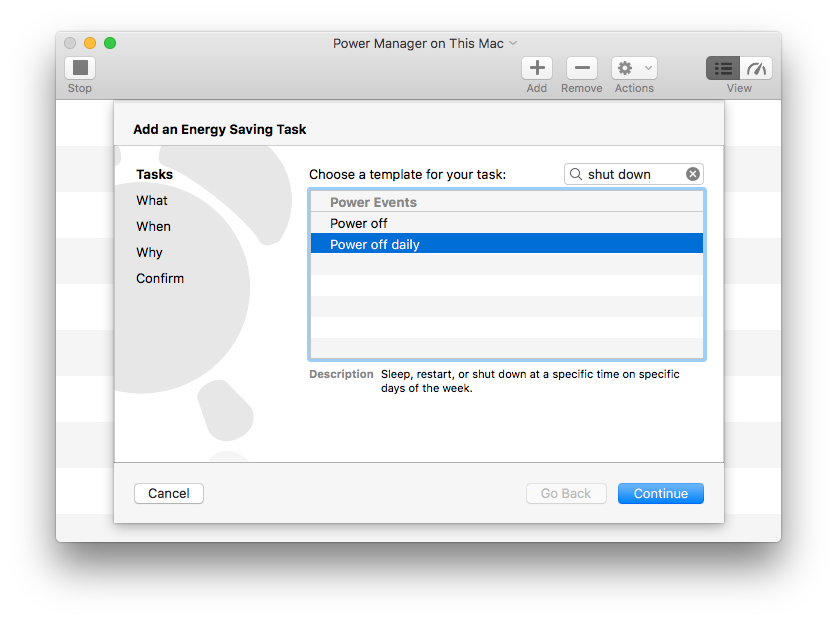Power Manager For Mac

PowerShell supports macOS 10.12 and higher.All packages are available on our GitHub releases page.After the package is installed, run pwsh from a terminal.
Note
Power Manager is the solution for reducing the energy costs of Mac computers. Use Power Manager to assert control over when your Macs are available.
PowerShell 7 is an in-place upgrade that removes PowerShell Core 6.x.
The /usr/local/microsoft/powershell/6 folder is replaced by /usr/local/microsoft/powershell/7.
If you need to run PowerShell 6 side-by-side with PowerShell 7, reinstall PowerShell 6 using thebinary archive method.
About Brew
Homebrew is the preferred package manager for macOS. If the brew command is not found, youneed to install Homebrew following their instructions. Otherwise you may install PowerShellvia Direct Download or fromBinary Archives.
Installation of latest stable release via Homebrew on macOS 10.12 or higher
See About Brew for information about Brew.
Now, you can install PowerShell:
Solution manual to macroeconomics blanchard. Macroeconomics 7th Edition Blanchard Solutions ManualIn Macroeconomics, Blanchard presents a unified, global view of macroeconomics, enabling readers to see the connections between goods, financial markets, and labor markets worldwide.
Finally, verify that your install is working properly:
When new versions of PowerShell are released,update Homebrew's formulae and upgrade PowerShell:
Note
The commands above can be called from within a PowerShell (pwsh) host,but then the PowerShell shell must be exited and restarted to complete the upgradeand refresh the values shown in $PSVersionTable.
Installation of latest preview release via Homebrew on macOS 10.12 or higher
See About Brew for information about Brew.
After you've installed Homebrew, you can install PowerShell.First, install the Cask-Versions package that lets you install alternative versions of cask packages:
Now, you can install PowerShell:
Finally, verify that your install is working properly:
When new versions of PowerShell are released,update Homebrew's formulae and upgrade PowerShell:
Note
The commands above can be called from within a PowerShell (pwsh) host,but then the PowerShell shell must be exited and restarted to complete the upgrade.and refresh the values shown in $PSVersionTable.
Installation via Direct Download
Grid 2 mac download. download grid for mac free. Download the PKG packagepowershell-lts-7.0.0-osx-x64.pkgfrom the releases page onto your macOS machine.
You can double-click the file and follow the prompts,or install it from the terminal:
Install OpenSSL. OpenSSL is needed for PowerShell remoting and CIM operations.
Install as a .NET Global tool
If you already have the .NET Core SDK installed, it's easy to install PowerShellas a .NET Global tool.

The dotnet tool installer adds ~/.dotnet/tools to your PATH environment variable. However, thecurrently running shell does not have the updated PATH. You should be able to start PowerShellfrom a new shell by typing pwsh.
Binary Archives
PowerShell binary tar.gz archives are provided for the macOS platform to enable advanceddeployment scenarios.
Installing binary archives on macOS
Install OpenSSL. OpenSSL is needed for PowerShell remoting and CIM operations.
Installing dependencies
Install XCode command-line tools
Install OpenSSL
OpenSSL is needed for PowerShell remoting and CIM operations. You can install via MacPorts.
Install OpenSSL via MacPorts
- Install the XCode command line tools.
- Install MacPorts.If you need instructions, refer to theinstallation guide.
- Update MacPorts by running
sudo port selfupdate. - Upgrade MacPorts packages by running
sudo port upgrade outdated. - Install OpenSSL by running
sudo port install openssl10. - Link the libraries to make them available to PowerShell:
Uninstalling PowerShell
If you installed PowerShell with Homebrew, use the following command to uninstall:
If you installed PowerShell via direct download, PowerShell must be removed manually:
To remove the additional PowerShell paths, refer to the paths section in this documentand remove the paths using sudo rm.
Note
This is not necessary if you installed with Homebrew.
Paths
$PSHOMEis/usr/local/microsoft/powershell/7.0.0/- User profiles will be read from
~/.config/powershell/profile.ps1 - Default profiles will be read from
$PSHOME/profile.ps1 - User modules will be read from
~/.local/share/powershell/Modules - Shared modules will be read from
/usr/local/share/powershell/Modules - Default modules will be read from
$PSHOME/Modules - PSReadline history will be recorded to
~/.local/share/powershell/PSReadLine/ConsoleHost_history.txt
The profiles respect PowerShell's per-host configuration.So the default host-specific profile exists at Microsoft.PowerShell_profile.ps1 in the same locations.
PowerShell respects the XDG Base Directory Specification on macOS.
Because macOS is a derivation of BSD, the prefix /usr/local is used instead of /opt.So, $PSHOME is /usr/local/microsoft/powershell/7.0.0/, and the symbolic link is placed at /usr/local/bin/pwsh.
Additional Resources
The ultimate toolbox for Photos on your MacPowerPhotos works with the built-in Photos app on your Mac, providing an array of tools to help you get your photo collection in order. Create and manage multiple librariesInstead of being limited to putting all your photos in a single library, PowerPhotos can work with multiple Photos libraries, giving you many more options for how to organize your ever growing photo collection.Splitting your photos between multiple libraries helps Photos open more quickly, lets you archive older photos, store some of your collection on an external hard drive, and reduce storage space used by iCloud Photo Library. Links and reviews'PowerPhotos is an extremely useful addition as an enhancement for any Photos user trying to perform tasksthat fall outside of Photos restricted purview.' –'PowerPhotos may lack the punch of its predecessor, iPhoto Library Manager, but it’s indispensable for those making the transition to Photos.' –Video tutorial: Remove duplicate photos in Photos for Mac –'PowerPhotos was just what I needed Two features make it a must-have: merging multiple Photos libraries into one, and finding duplicate photos' –.